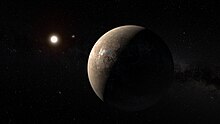Simulations show planet orbiting Proxima Centauri could have liquid water
Thursday, May 18, 2017
In findings published Tuesday in Astronomy and Astrophysics, a team of scientists led by Ian Boutle at the University of Exeter have created successful simulations of two possible atmospheres of Proxima B, an exoplanet orbiting Proxima Centauri, one a simple atmosphere of nitrogen tinged with carbon dioxide and another an Earth-like mix of gases. They found it possible that liquid water, a prerequisite for life as we know it, might exist on parts of the planet.

Image: European Southern Observatory.
The University of Exeter's lead exoplanet modeller, Dr. Nathan Mayne, in remarks to Wired, said, "If, and it is a huge if, the composition of the atmosphere was Earth-like then we showed the planet could indeed support temperatures which would allow liquid water on the surface". In another statement, he emphasized researchers could also "exploit this to hopefully improve our understanding of how our own climate has and will evolve".
Proxima B is believed roughly Earth-sized and in its solar system's habitable zone, meaning it would have similar gravity to Earth and at least the possibility of liquid water. The exoplanet was discovered in August 2016 about 4.2 light years from Earth. Last year, NASA put out a statement expressing doubt that the planet could have an atmosphere in the sense that most of us understand it: "Considering the host star's age and the planet's proximity to its host star, the scientists expect that Proxima B is subjected to torrents of X-ray and extreme ultraviolet radiation from superflares occurring roughly every two hours."
Co-author Dr. James Manners said, "One of the main features that distinguishes this planet from Earth is that the light from its star is mostly in the near infra-red[...] These frequencies of light interact much more strongly with water vapour and carbon dioxide in the atmosphere which affects the climate that emerges in our model."
This new model allowed scientists to evaluate the effects of Proxima B's possible orbits and likely exposure to radiation and solar flares from its red dwarf sun on two types of atmospheres. The specifics of Proxima B's orbit are not yet established. It might rotate around its axis quickly the way Earth does or it might be tidally locked to its sun, with one side of the planet always lit and the other always dark. It might have a near-circular orbit or an elliptical one. All these variations would have different effects on the flow of any gases over its surface. The models described in this paper review two possible orbits: one tidally locked and one modeled after Mercury's, with a slow-rotating three days per year.
The team used the Met Office Unified Model to produce the simulations.
Sources
- Ian Boutle, Nathan Mayne, Benjamin Drummond, James Manners, Jayesh Goyal, Hugo lambert, David Acreman, and Paul Earnshaw. "Exploring the climate of Proxima B with the Met Office Unified Model" — Astronomy and Astrophysics, May 16, 2017
- Abigail Beall. "'Second Earth' Proxima b could support alien life after all" — Wired, May 15, 2017
- Eurekalert. "Scientists take first tentative steps to explore potential climate of Proxima B" — University of Exeter, May 15, 2017
